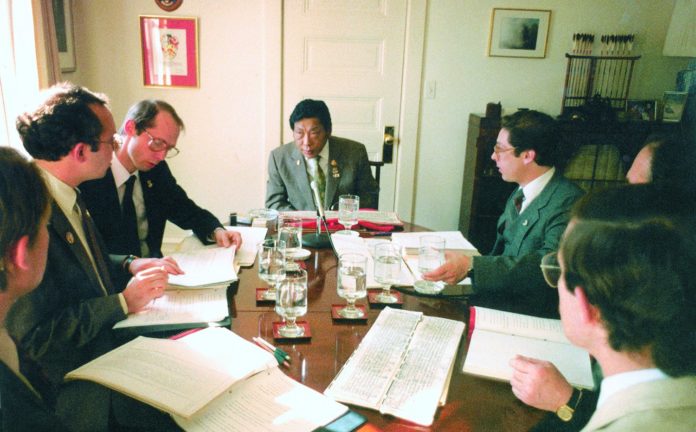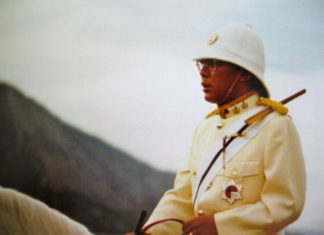
A Discussion with Chögyam Trungpa Rinpoche and the NTC
The Nalanda Translation Committee,
Kalapa Court in Boulder, Colorado,
Circa 1980.
Left to right: Nelson Dudley, Scott Wellenbach, Lodro Dorje, Chögyam Trungpa, Larry Mermelstein, Sherab Chödzin, John Rockwell
The character and style of translation meetings with the Vidyadhara were often fairly straightforward and businesslike. There was a job at hand, translating a dharma text, usually from Tibetan into English. So we all followed our teacher’s lead and generally stayed on task, unless of course he leaned out into the wind a bit, which sometimes resulted in a gem of a conversation like the following. In the midst of digitizing and archiving our old tapes of translation meetings, Tingdzin ötro rediscovered this jewel, and we are happy to present it to you here.
The following discussion took place during a translation meeting on The Rain of Wisdom at the 1979 Vajradhatu Seminary. Present at the meeting were the Vidyadhara (VCTR), Robin Kornman (RK), Jud Levinson (JL), Larry Mermelstein (LM), John Rockwell (JR), and Scott Wellenbach (SW). This edited transcript represents only a fraction of the entire discussion, which will appear soon on the Nalanda Translation Committee’s website under Translation Offerings.
According to the Tibetan understanding of the yogachara view, there are eight consciousnesses. The eighth, called the alaya-vijnana, is the basis for the other seven. The ati tradition presents an ultimate alaya (San.; “abode, receptacle”; Tib. künshi; “ground of all”), which is the basis of both samsara and nirvana. The Vidyadhara described this ultimate alaya and the split from it in this way:
This basic ground does not depend on relative situations at all. It is natural being which just is. Energies appear out of this basic ground and those energies are the source of the development of relative situations. Sparks of duality, intensity and sharpness, flashes of wisdom and knowledgeall sorts of things come out of the basic ground. So the basic ground is the source of confusion and also the source of liberation. . . . As for ego’s type of ground, the eighth consciousness, this arises when the energy which flashes out of the basic ground brings about a sort of blinding effect, bewilderment. That bewilderment becomes the eighth consciousness, the basic ground for ego. [Garuda IV: The Foundations of Mindfulness; p. 58]
In addition to the alaya of the eighth consciousness and the alaya of the basic ground, the Vidyadhara here presents a third type of alaya, a knowing that is self-aware and self-luminous (Tib. shepa rang rik rang sel).

VCTR: Generally, there are different types of alaya: a lower level, or storehouse consciousness, and a higher level, which is basic brilliantness.
JL: It is pure tathagatagarbha.
VCTR: So to speak.
JL: If the higher level of alaya is brilliance, is there also a dharmakaya level of alaya Is there a formless purity before it becomes luminous
VCTR: Yes. According to vajrayana, there is the dharmata itself, which you return to at the moment of your death. It is just dissolving. After the moment of death, there is the bardo of dharmata, which goes beyond the alaya, even beyond the brilliance. It is just a kind of blanknessdead. JL: So the vajrayana seems to say that there are three types of alaya: complete purity or dharmata, luminosity, and the alaya that gives birth to grasping.
VCTR: Yes.
RK: I take it that the lower alaya, which is responsible for our ego, is not still.
VCTR: It is fickle.
RK: In shamatha practice, it seems that thoughts are being thrown out, and I am bubbling and throwing them out. There is no sense of complete peace, but there is a sense of being behind the thoughts as they come out. Is that the lower alaya
VCTR: It could be seeing the lower alaya, though connected with the luminous aspect a little bit. If you are in the state of fickleness, you cannot see it because you are it. You begin to see it because you are beginning to be a little more steady; therefore you have a reference point. The reason you see the fickleness might be because the luminous aspect allows you to step back a little.
JL: Is the point of coemergence, or split, in that luminous alaya
VCTR: No, the split is at the level of dharmata. When you reach the bardo of dharmata, you have a chance of either splitting downward or not. That is where coemergent ignorance and coemergent wisdom arise.
RK: If you wake up from the bardo of dharmata and go in the direction of coemergent ignorance, are you then presented with the lights
VCTR: Yes. But that point is slightly hopeless, because you are already in duality.
RK: But if you go in the direction of coemergent wisdom, are you enlightened
VCTR: Well, you at least glimpse it.
LM: In the past, we have discussed two types of alaya: one that is a sense of very primordial egolike consciousness and the other that is much more kosher. What is the third one
VCTR: Dharmata.
JL: At that point, there is not even luminosity.
VCTR: There are two kinds of luminosity: that of coemergent wisdom and that of the basic alaya.
JL: Does the luminosity of coemergent wisdom take place after the split
VCTR: Yes.
JL: Are there two kinds of brilliance, coemergent-wisdom brilliance and a coemergent-ignorance light that continues down into the basic alaya
VCTR: No. The separation takes place at the level of dharmata, which is dull.
RK: By “separation,” do you mean coemergent wisdom
VCTR: Or ignorance.
RK: Is the lower alaya at the post-split level on the side of samsara
VCTR: Yes.
RK: Is the higher alaya also post-split
VCTR: No, the higher alaya is neutral.
LM: Is that the alaya referred to in the slogan, “Rest in the nature of alaya”
VCTR: Mm-hmm.
LM: What is the term for the higher alaya
VCTR: It is the “ultimate alaya” (Tib. tön-gyi künshi) or “perfectly pure ultimate alaya” (yangdak pe tön-gyi künshi). Out of that ultimate alaya, you could have a split. Finally, ultimate alaya is the atmosphere where the split can occur.
RK: When you have coemergent wisdom, there is both a sacred side and a samsaric side.
VCTR: Yes.
RK: Where does the sense of enlightenment or sacredness come from Is it sacred because it comes out of the ultimate alaya
VCTR: You could say that. Ultimate alaya at least holds the potentialities of the whole thing. We could say that samsara came out of some kind of freedom. That is the basic logic of why anyone can attain enlightenment.
RK: In meditation, is our approach to identify with the ultimate alaya
VCTR: New practitioners try to meditate with the self-aware, self-luminous aspect.
RK: When meditators practice coemergent wisdom, is the sense of the ground what makes it coemergent wisdom instead of coemergent ignorance
VCTR: Yes. You try to tune yourself into the ultimate alaya, and from there you try to flash.
RK: You flash on phenomena evolving VCTR: Yes.
RK: You drop back to the point before thought arises, then you let the thought arise, but you flash on it as it arises.
VCTR: Not quite. You do not flash “on course.” You just flash.
LM: It is like saturating yourself first, then you let go of that. VCTR: Yes. When you create pressure, then you can pop the balloon.
JL: Are you popping the balloon of your thoughts
VCTR: You are popping your alaya.
JR: Then quite anything could come out [laughter].
SW: Does it come out as sacred
VCTR: Absolutely, yes. You have sacred outlook.
RK: It is like you have a balloon full of water and a swimming pool. You drop the balloon into the swimming pool and then pop it.
LM: Or you swell up your balloon with whatever, then pop it by going out.
VCTR: Yes.
LM: And what you pop into would be sacred, the ultimate alaya.
VCTR: Then you could go a little beyond the ultimate alaya.
JR: Does this relate to “First thought, best thought”
VCTR: Yes, very much so.
RK: So it is like you hold it, pop it, and then drop into ultimate alaya, or a little bit before.
VCTR: You hold it in the ultimate alaya. You pass beyond the luminous mind, or lower level. You hold it in the ultimate alaya, and then you pop it there.
LM: Then that is what you are left with.
VCTR: That is the level where you can actually transcend karmic force. Once you slowly go downward toward the luminous mind, you are bound by karma. So you are helpless in some sense; you have been forced. That is where the seventh consciousness comes from.
JL: Once it is popped, you start coming back down again. You expand back in through phenomena.
VCTR: Sometimes you just pop and then come back, because you cannot sustain it. But if you pop it many times, you are able to sustain it more. The idea is to flash as much as you can so that you will finally be able to sustain it.
JL: Then you just dwell there.
VCTR: “Dwell” is not exactly the right word.
JL: How would you describe it
VCTR: There is some level of awake and space, I suppose.
JL: No subject and no object.
VCTR: No. You come down from the dharmakaya level to the sambhogakaya level.
LM: So are we talking about the dharmakaya principle
VCTR: We are talking about the “first buddha,” which we usually refer to as Samantabhadra and which is higher than Vajradhara.
LM: So this is the dharmakaya of dharmakaya.
VCTR: Right, which is a very early stage, even beyond the ultimate alaya.
LM: Would the ultimate alaya have more sense of dharmakaya or sambhogakaya
VCTR: There is not very much there. It is just the atmosphere where the split can occur, a sort of neutral ground. It is not related to the kayas at all.
SW: It is like dharmadhatu
VCTR: Dharmadhatu is beyond that. Dharmadhatu is before the first buddha. That is why we describe it with such terms as “simplicity,” “unchanging,” and “fresh.”
RK: When you hold yourself back in the ultimate alaya, is there a sense of holding discursive thoughts still
VCTR: You have to retreat back to the origin. It is holding discursive thoughts and also going beyond the luminous aspect.
RK: You cannot possibly hold it, so you drop it.
VCTR: You pop it.
RK: And you do not entertain any doubts about this process.
VCTR: That is why it is called the “fourth moment beyond the three.” It is so minute. It is subtle and vajra, like the middle of space.
JL: Therefore it is outside of time.
VCTR: Yes.
JL: Therefore there is no karma.
VCTR: Yes.
LM: Since coemergence occurs before the luminous alaya, could the result or footprint of coemergence tie into the experience of that alaya It comes after you have coemerged, but you notice it somewhat after the fact. There is some dropping of fixation, but it is not complete, since there is still some samsaric mind.
VCTR: You poke your head up, but it goes back because you are still pulled back by your karma.
RK: So you keep on poking your head up.
VCTR: That is right.
RK: The more pokes, the better.
VCTR: Yes.
© 2007 Nalanda Translation Committee
















